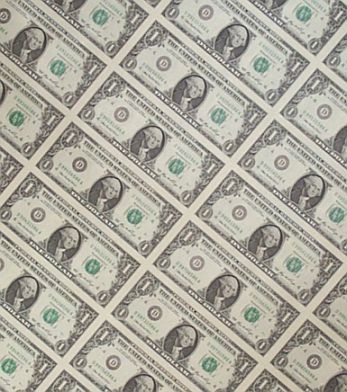Gold Financial Perspective - January 2009
Gold Financial Perspective - November 2009>
Gold Financial Perspective - August 2009>
Gold Financial Perspective - May 2009>
H.S. Perlin Co., Inc.
Gold Financial Perspective
Volume 5 Issue 1 - January 2009
This newsletter is designed to provide timely and beneficial financial information. Current economic factors affect your personal financial decisions as well as your decisions for gold ownership today. We hope you find the enclosed information helpful and informative.
Expectations for Gold in 2009
With the New Year bringing a continuation of bank declines, rising unemployment and an increasingly insecure economic forecast, what can we put our faith in? The end of 2008 saw the greatest economic downturn in nearly eighty years. Market valuations declined to the excess of 30 trillion dollars. The average value of the U.S. home fell nearly 25%. Prosperous, loan giving institutions were suddenly the ones in need. The U.S. economy lost 2.6 million jobs in 2008, and unemployment rose .4%, from 6.8% to 7.2%, in the month of December alone.
The end of 2008 saw the greatest economic downturn in nearly eighty years. Market valuations declined to the excess of 30 trillion dollars. The average value of the U.S. home fell nearly 25%. Prosperous, loan giving institutions were suddenly the ones in need. The U.S. economy lost 2.6 million jobs in 2008, and unemployment rose .4%, from 6.8% to 7.2%, in the month of December alone.
In the face of all of these global financial losses, we witnessed gold continue to rise. Impressively, the previous eight consecutive years show gold rising at a rate of 15% or more per annum. Therefore, with the background of a bursting economic bubble, gold has continued to hold its value. As expected, the precious metal preserved capital by falling less than most assets and acting as a reverse hedge.
What does this trend say about gold in 2009?
Although the metal is not immune to declining prices with the onset of deflation, 2009 will show gold continue to serve investors. A more severe deflationary spiral in 2009 could lower the values of all products, goods and services as well as gold. However, the Bloomberg Annual Metals Survey predicts that "the best-performing metal in 2008 may appreciate for [another] year as investors seek a refuge from declining interest rates at the same time that central banks inject more cash into the banking system." The survey predicts gold will average $910 this year, increasing from $872 in 2008. This estimate is the median of several predictions made by various prestigious U.S. investment companies, which range from $810 to $1200.
"People fear inflation, they fear the credit crunch and they fear currency losses, and gold is the perfect insurance against all of that," says Frederic Panizzutti, a senior vice president at Geneva-based bullion refiner MKS Finance SA. Panizzutti, the most accurate forecaster in the London Bullion Market Association's 2008 survey, forecasts gold will average more than $900 in the first half of 2009.
Bank of America Begs and Citigroup Splits
The two teetering institutions receive record levels of government assistanceUnbeknownst to the public until recent reports, Bank of America struck a controversial deal with top government financial officials back in mid-December. In a meeting with BofA CEO Ken Lewis, Treasury Secretary Hank Paulson and Fed Chairman Ben Bernanke ensured BofA enough government aid to entirely cover the losses of the company's recent acquisition, Merrill Lynch & Co. The Wall Street Journal's "BofA's Latest Hit" attributes the promise to the officials' fear that the bank would pull out of the Merrill Lynch transaction, thereby shocking the fragile financial system.

BofA purchased the failing company without government assistance in mid-September amidst the chaos of the failure of the Lehman Brothers and AIG. Since acquiring Merrill Lynch, the bank received an unprecedented $25 billion in aid from the Troubled Assets Relief Program (TARP) in October, which Lewis claimed at the time was "unneeded" and "reluctantly accepted."
Last week, BofA announced it needed an addition $20 billion from TARP to cover further Merrill Lynch losses. This brings the American taxpayers' total aid contribution to $45 billion, sending the company to the top of the TARP recipients list.
Who else competes with BofA's monumental TARP contribution?
JP Morgan/Chase and Wells Fargo are fourth on the list, with $25 billion each and AIG comes in third with $40 billion in government financial aid. Also topping the cart, matching BofA's $45 billion is Citigroup, which is undergoing hefty reconstruction in an attempt to escape dire financial circumstances. In order to cope with over $28.5 billion in losses in the last year and a half, Citigroup announced on Friday that it will divide into two units, to reorganize the bank's various financial operations.
With major banks making massive changes in order to avoid failure, the people's faith in the banking system continues to dwindle. Shares of stock in many major U.S. lenders are still falling, including Bank of America, which has tumbled to its lowest level since 1991.
The public sits in wait to see how BofA and Citigroup will survive with their TARP contributions. Even with the financial rescue, each must face the management of continuing onslaughts of bad loans in an economic recession that will only worsen the burden.
Gold Around the World: India
The religious and cultural significance of this precious metal influences the form of its production as well as the astonishing level of its consumptionAfter the first known bits of gold were discovered in streams all over the world, it's astonishing qualities immediately established the metal as a precious commodity. Gold's brilliance, luster, great malleability and resistance to tarnish made it desirable to work with, resulting in its production into a variety of different forms, and its use for numerous financial and social purposes.
For over 6,000 years, gold has functioned as ornament, being made into jewelry for objects, clothing and various body parts. Because of its extraordinary visual qualities, gold adornment has historically been associated with godly greatness and is often used in connection to religious worship. Its intrinsic value paired with religious tradition and ritual has led gold to become of great cultural importance to many societies, extending its value beyond monetary worth.
 In India, gold is deeply woven into the fabric of society through its religious significance. Along with its use as the ultimate description of beauty in descriptions of god and goddess, gold is a central element in the Hindu creation story. In the story the Creator drops a seed into the water he makes from his own body. The seed becomes a golden egg, from which the incarnation of the Creator, Brahma, is born.
In India, gold is deeply woven into the fabric of society through its religious significance. Along with its use as the ultimate description of beauty in descriptions of god and goddess, gold is a central element in the Hindu creation story. In the story the Creator drops a seed into the water he makes from his own body. The seed becomes a golden egg, from which the incarnation of the Creator, Brahma, is born.
The metal is so obviously important in religious creed that Manu, the ancient law-giver, decreed that golden ornaments must be worn for specific ceremonies and occasions. As a result, Indian customs now demand buying gold for special occasions like weddings, births, birthdays, festivals and as religious offerings to deities.
Still 70 percent rural, the vast country of India is a heterogeneous melting pot of differing sub-cultures, customs, communities, and cooking and dressing habits. Despite the immeasurable differences between Indian citizens, the love of gold is universal. It is the only item that permeates every class and every strata of Indian society. Because of these elements, gold has become an inseparable part of the Indian society and is fused into the psyche of every citizen. Indians see the metal as more than luxury, but as a symbol of purity, prosperity and good fortune.
As a result, Indian is the world's top consumer of gold. The country's consumption of the commodity far surpasses wealthier and more developed countries because of gold's unbreakable ties to religion, and Indian citizens' view of gold as a necessity rather than a luxury.
Inflation is Inevitable
The government's financial bailout is meant to save the economy, but the source of the money will inevitably stimulate major inflationThe economic downturn, the credit crunch and rising unemployment have all contributed to the nation's current deflationary state. The unprecedented Stock Market losses of the previous year have additionally brought on this condition, where prices for goods and services fall and the dollar seems more valuable. Being that deflation is an outcome of negative economic factors, the government is moving to correct the situation by pouring money into various stimulus plans in order to forestall the possibility of another Great Depression.
 With nearly $11 trillion dollars of national debt already in place, what will be the affect of the additional funds needed for TARP's $700 billion payout, the Federal Reserve's $800 billion Consumer Loan and Bond Plan, and the House of Representative's $825 billion Economic Stimulus Plan?
With nearly $11 trillion dollars of national debt already in place, what will be the affect of the additional funds needed for TARP's $700 billion payout, the Federal Reserve's $800 billion Consumer Loan and Bond Plan, and the House of Representative's $825 billion Economic Stimulus Plan?
We all know that money does not grow in trees, but clearly the U.S. government and Fed have no problem making it grow at an unlimited rate from their printing presses. With printing in progress to fund these programs, and those that are to come, the nation is experiencing a deflation that will quickly turn to inflation as this money saves us from economic disaster. After an estimated year's time when this windfall hits public circulation, we can be sure prices will once again rise and a period of inflation or hyper-inflation will begin.
 USA Patriot Act Provisions
USA Patriot Act Provisions